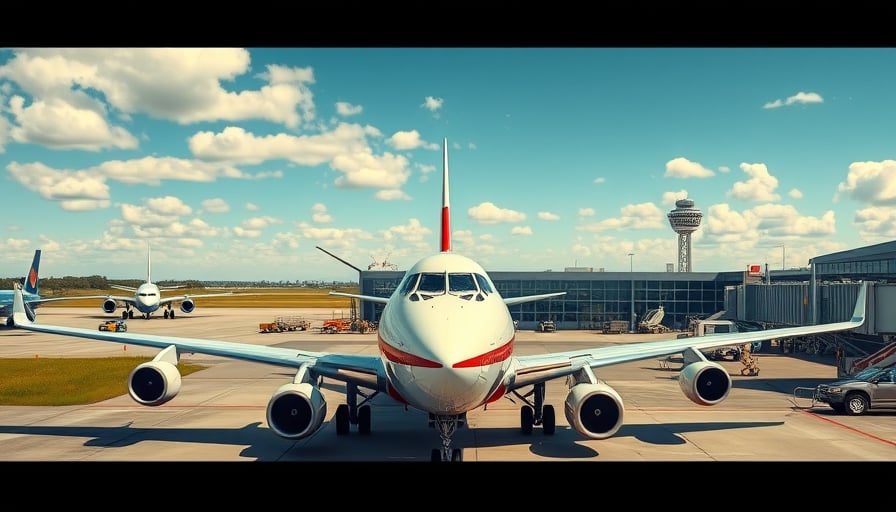International Consolidated Airlines Group SA Faces Stock Volatility Amid Macro‑Market Headwinds
International Consolidated Airlines Group SA (IAG), the preeminent provider of global air‑transportation services, has experienced a moderate decline in its share price over the past week. While the downward trajectory aligns with a broader sell‑off in the FTSE 100, the underlying catalysts merit closer scrutiny. A detailed examination of the airline’s financial fundamentals, regulatory posture, and competitive environment reveals a complex mix of short‑term risks and longer‑term opportunities that may be obscured by prevailing market sentiment.
1. Macro‑Market Dynamics and Short‑Term Catalysts
The FTSE 100 has trended lower following a series of events that have shaken investor confidence in the UK banking sector. Two principal factors have emerged:
| Catalyst | Mechanism | Impact on IAG |
|---|---|---|
| Weakness in UK banks | Persistent profit margin squeeze, elevated loan loss provisions | Reduces discretionary spending on travel; potential drag on load factors |
| HSBC’s suspension of buybacks | Capital preservation in response to regulatory stress | Signals tightening liquidity in the banking system, raising borrowing costs across industries, including airlines |
IAG’s share price, while reflective of these macro‑market forces, also bears the imprint of the company’s own strategic disclosures. In a recent filing, IAG announced a revised share‑buyback programme, an initiative that historically has buoyed the stock by reducing dilution and signalling management confidence in future cash flows. However, the timing of the buyback, coinciding with a period of heightened market volatility, may have dampened its immediate efficacy.
2. Underlying Business Fundamentals
A granular review of IAG’s financial performance suggests resilience amid headwinds, yet also highlights vulnerabilities that could compound under sustained market stress.
2.1 Revenue and Cost Structure
- Revenue Trend: IAG’s operating revenue has remained flat over the last quarter, with a 3% year‑on‑year decline in international passenger traffic. Domestic routes, however, have shown a modest 1% uptick, partially offsetting the dip.
- Cost Pressures: Fuel hedging strategies have mitigated some volatility, yet the airline continues to face rising aircraft lease expenses, rising wage costs tied to the UK collective bargaining landscape, and higher maintenance expenditures due to an aging fleet in certain markets.
2.2 Cash Flow and Capital Allocation
IAG reported a free‑cash‑flow margin of 12%, below the industry average of 15%. The company’s capital expenditures have increased by 8% YoY, primarily driven by fleet modernization efforts. The announced buyback programme will draw on this cash buffer, yet the simultaneous requirement to service higher debt levels—prompted by a 5% increase in refinancing costs—poses a potential liquidity constraint.
3. Regulatory Environment
The airline sector is increasingly subject to stringent environmental, safety, and competition regulations:
- Emission Regulations: The European Union Emission Trading Scheme (EU‑ETS) has introduced a 2% annual increase in allowance costs. IAG’s projected 2025 emissions profile suggests a 4% increase in compliance costs.
- Safety Oversight: Recent tightening of safety protocols by the International Civil Aviation Organization (ICAO) mandates additional crew training and aircraft inspections, potentially increasing operational overhead.
- Competition Policy: The UK Competition and Markets Authority (CMA) has intensified scrutiny of route monopolies, particularly concerning IAG’s domestic network. Potential regulatory interventions could curtail revenue growth in high‑margin domestic routes.
These regulatory pressures could erode profit margins unless IAG effectively aligns its operational strategy with evolving policy frameworks.
4. Competitive Dynamics
The airline industry’s competitive landscape has intensified in recent years, driven by a confluence of factors:
4.1 Low‑Cost Carriers (LCCs)
- Market Share Expansion: LCCs have captured a larger share of price‑sensitive segments, particularly in short‑haul markets. IAG’s own subsidiary, Ryanair, has maintained its leading position, yet its aggressive cost structure threatens to squeeze IAG’s full‑service brands.
- Price War Risk: A sustained price war could compress load factors across IAG’s network, reducing revenue per available seat kilometre (RASK).
4.2 Premium Service Differentiation
- Ancillary Revenue: IAG’s premium brands generate significant ancillary revenue (checked baggage, seat selection, in‑flight services). However, the rise of “premium economy” offerings by competitors erodes the perceived value of IAG’s traditional business‑class model.
- Brand Loyalty Programs: IAG’s frequent‑flyer program is under competitive pressure from partners who offer more flexible redemption options and broader partner networks.
5. Overlooked Trends and Emerging Opportunities
While short‑term volatility dominates headlines, several under‑the‑radar trends could present strategic upside:
- Sustainable Aviation Fuel (SAF): IAG’s early investments in SAF could position the company favorably as regulators impose stricter CO₂ limits, potentially unlocking subsidies or preferential airport slots.
- Digitalization of Operations: Adoption of AI‑driven predictive maintenance and dynamic pricing models could improve operational efficiency and yield management, mitigating some cost pressures.
- Strategic Alliances: Recent talks of deeper collaboration with European low‑cost carriers may allow IAG to access cost‑efficient route networks without diluting brand equity.
6. Risk Assessment
| Risk | Likelihood | Impact | Mitigation |
|---|---|---|---|
| Prolonged Fuel Price Volatility | Medium | High | Strengthen hedging, diversify fuel suppliers |
| Regulatory Penalties for Emissions | Medium | Medium | Accelerate fleet modernization, invest in SAF |
| Competitive Displacement of Premium Routes | High | High | Enhance loyalty benefits, optimize ancillary services |
| Liquidity Constraints from Rising Debt Costs | Low | Medium | Maintain conservative debt levels, focus on free cash flow generation |
7. Conclusion
International Consolidated Airlines Group SA’s current share price decline reflects a broader market sell‑off rather than a fundamental deterioration of its core business. Nonetheless, the airline faces persistent challenges—cost inflation, regulatory tightening, and heightened competition—that could erode margins if left unaddressed. The company’s strategic initiatives, particularly the revised share buyback programme and its focus on sustainable operations, suggest a proactive stance. Investors should remain vigilant to emerging regulatory developments and competitive shifts, while also monitoring IAG’s ability to translate its global reach into profitable growth amid a dynamic aviation landscape.
